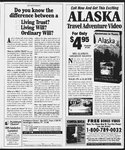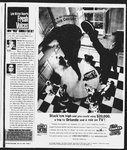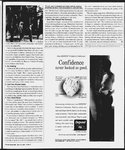| OCR Text |
Show The Salt Lake Tribune NATION Sunday, May 23, 1999 Nevada Cave Is ‘Noah’s Ark’ of 50,000-Year-Old Specimens Cheetah, camel and llama remains offer idea of Africa-like West in ancient times Se “Thereal answer is Researcher Kelly MeGu corded the findings — ineluding horse and bigheaded llama — in anarticle published in 1980 But they didn't radiocarbon BY SCOTT SONNER Angeles County Museum THE ASSOCIAT date the remains and apparently ‘There was no fanfair, no bells or whistles,” Hockett said. “I was Just sitting in the mammal section with nobodyaroundlooking at the skeletonof a cheetah — just you and the bone.” The bones are in the back of a were unawareof four oer sections of the cave. includ the back section with the oldest bones, Thereare alot oftight places RESS ELKO, Nev. — Cheetah, camel and llama bones sealed in the deep freeze of a Nevada cave for tens of thousands ofyearsare givingscientists a rare glimpseat the Africa-like grassland that cov- left their mark in the Sulpher Spring Range about vores that dragged prey back to television, read McGuire's work in college and remembered whenhe started working for the BLM in Elko in 1991 feed their young The find is evidence of the wild head. Llamas are pretty rare in ern United States before the last Nevada. When I started working at the BLM. | he: 4 rumor it 300 miles east of Reno, was a den for bobcats or other large carni- nowextinct — from the giant short-faced bear to huge deer and bisonspecies. “It just stuck in the back of my lydiverse ecosystem in the West- caveis kind of a Noah’s- Ark collection of species,” said big Ice Age 18,000 years was a vast gr: TomStafford, a Boulder, Colo. based specialist who has been like the savannas torial Africa,’ At 40 degrees, high humidity and 7.000-feet altitude, the condi- of Africa, equaHockett said That's one place where you've hada lot of big grazers and carni- tions at the back of the dark cave are identical to those of a modern refrigerator. Perhaps mostintriguing to the scientists are the intact twigs. vores. But it would have had to have been a lot cooler and wetter Alot of different trees,” like pine and spruce, he said leafs, seeds and animalhair from nothingleft quitelike this. There to extract DNA to compare the is nothing that is as diverse asthis. genetic makeup of past and present species. “We could see how much evolu- It is unmatched in the world tojay Some of the bones are fromani- said Bryan mals with funny names, like the “bigheaded lama” and “yesterday's camel." They come fromthe of Land Management archaeologist. who discovered the find nearly three er's pil Ria Donovan The Associated Press BLM archaeologist Bryan Hockett compares two toe bones found among trove of bonesin a Pine Valley, Nev., cave. day because the American prong- ‘The real answer is, there is whichtheybelieve they'll be able Bureau ing satellite unit to locate the cave in the Pine Valley south of Carlin He found McGuire's original test excavation site in the front of the cave as well as a more recently dug holethat “lookedlike a loot to 12,000 yearsago. Some say maybe it would be “I can't wait to get there,” he said. “I’m drooling the might be on BLMlands.” he said. Hockett useda global position- well before manis believed to have arrived on the scene 10,000 ing tests on the bones. tion there has been,” ago. It and where large predators stalked grazing animals conducting the radiocarbon-dat- Hockett, sai Hockett, who grew up watching National Geographic spe on 1860s Hockett suspectsthatthe cave, in 50,000 years ago includes bones froma widevarietyof creatures “This the horncan run so muchfaster than anything living here now that might have beena predator,” said Robert J. Emry. a paleo-biologist at the Smithsonian's Museum of Natural Historyin Washington “With the cheetah, somesay it of the the bonesevenif theygot inside “Thecaveis so dark, even with Part of the cave had been sur- veyed by a team of archeologist fromtheUnivers Davisin 19 e kept secret to pro: tect it against further damage But he doubts anyone could find hesaid. University of Research Institute “I kept saying to myself, ‘I can't believe we are finding this,’” Hockett said he doesn't know what to expect “Weknow quite abit about the “At most cave sites, at bedrock you areat 10,000 to 20,000 years I go in there I lose something, Hockett said ago andthat's it. These bones date The unique combination of by the unique way in which the to 40,000 to 50,000 years and those bonesaresitting onthe sur ‘ace. We've only madeapinprick bats andbirds. The giant short-faced bear — Hockett recalls. “It was just ‘Eureka!’ in terms of thescientific information.” Hockett, 37, and fellow BLM archaeologist Erie Dillingham among the rarer bones — had a short snout and longer legs than a typical bear. It was much larger than bears today and a fast run- 37, have been dragging bones out of the cave for the past two sum- There’s a little voice inside your head ner. that says “Spend Money.” ‘The cheetah remains are only mers and next month plan the largest expedition yet into the the second discovered in Nevada. 700-foot cavern. ed in North America Fewer than 10 have been record- Theyonlyrealized recently how ‘The cheetah remains may shed significant the bones were light on a question that has both- In January, they spent days ered scientists for decades: Why comparing dozens of bones to are pronghornantelopesofast? their counterpartsat the La Brea “There was always speculation that there must have beena faster-running predator during the Pleistocene than we know of to- Tar Pits in Los matched the che Africa cheetahskeletonat the Los Bank One's stigmata Savings Account Homeowners with moneyworries may qualify for low-interest loans LOANS: Direct lender loosens its re- Toe ject credit” Self-empl ed? Late house quirements for homeowners who » pay ments? Financial pr lems? Medi need money now al bills? IRS liens? Bankruptey? Ir Have you been tumed down tor a doesn't matter! d more than $10,000, If you are 4 homeowner with sutti eason? Are you pay re cient equity, there's an excellent chance han 10% interest on any other loans you will qualify for a loan—asually credit cards? within 48 hour vut over the phone and tree of c if you qualify Stone Castle Home | ans 1s live sed by the Utah Department of ( Call 1-800-700-1242, ext. 140 A Oo meet grant AN ill? SINCE 1866 re it t w tagheuer. com savings ning ey www bankone.com FOR TIER pEWELERS 266.9504 Plus, ause BANK= ONE tior 1 and the ialty. Se be a Bank Or accounts that offers y a Fashion Place Mall Desert » Gila River Indian Reservationin Ariz are horses, mountain sheep pronghorn antelope. wolves, weasels, badgers, coyotes, lizards, vation. yc Stafford is among those headed into the cave the third week of June for a major study of the con tents along with experts from the your lighting, that almost anytime creatures may be surpassed only 2 nation’s pre-eminent carbon-dat inglabs. It is just incredibly well pre served both physically and chemi cally. It's really bound to have DNA.” he said critters from 18.000 to 10,000 years ago becausethelast glacial surge was 18,000 years ago,” he said. “Weknowalot less about 20,000 to 40,000 or 50,000 years ago. He granted aninterview on the condition that the exact location mightexplain the pronghorn’s adaptation for swiftness — whatit was it adapted to escape from, bones have been pre: is ineredibly r said Stafford, who runs Stafford Re search Laboratories. one of the endof the Pleistocene Age. There years ago and is leading the exca Do Bryan Hockett BLM archaeologist whereyouhaveto craw! through on your stomach.” Dillingham 700-foot deep cave where miners ered much of the West before the last Ice Age. The unusually well preserved cache from about 40,000 to there is nothing like this. There is nothing that is as diverse as this. It is unmatel in the world today.’ it’s as her rate of returr your available ability to sure you talk with u acce y r CEMOLOGISTS Crossroads Plaza §34.0345 he Salt Lake Tribune http:/Awww.sitrib.com 1-888-298-9495 Business acco NTS: 1-800-404-4111 |






























































































































































































































